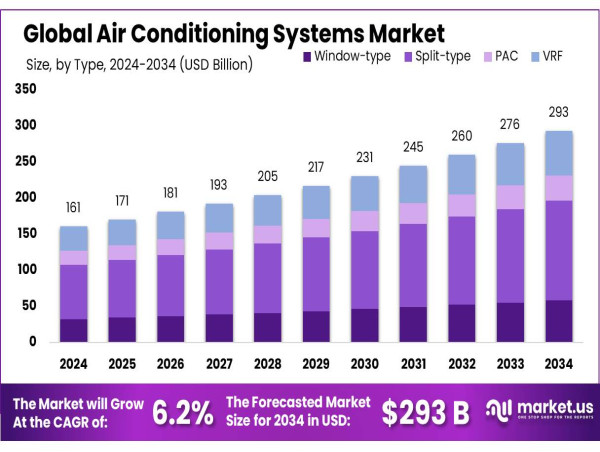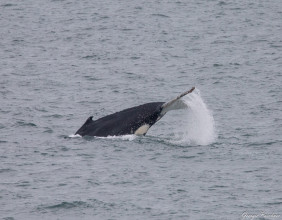The global Air Conditioning Systems Market has witnessed significant growth over the past few years, primarily driven by the increasing global temperatures and a rising standard of living across various regions. Air conditioning systems, which include both portable and fixed installations, are crucial in managing indoor air quality and temperature, making them indispensable in both residential and commercial settings. This industry has expanded its reach beyond mere comfort to becoming essential in health and efficiency-driven environments.
In the industrial scenario, the air conditioning market is segmented into residential, commercial, and industrial users, with further breakdowns based on the type of products such as unitary, split systems, chillers, and portable air conditioners. The market has seen a shift in preference towards energy-efficient and environmentally friendly systems due to rising energy costs and stringent regulatory policies aimed at reducing greenhouse gas emissions. Innovations such as inverter-based systems and those incorporating renewable energy sources are becoming increasingly popular, reshaping market dynamics.
Driving factors for this market include urbanization and the growth in the construction sector, particularly in emerging economies. As more people move to urban areas, the demand for residential and commercial building constructions has surged, thereby increasing the demand for air conditioning systems. Additionally, technological advancements that offer enhanced product efficiency and features, such as smart thermostats and systems integrated with the Internet of Things (IoT), are also significant contributors. These innovations not only improve user comfort and system manageability but also enhance energy conservation, which is a critical concern for consumers and governments alike.
The market faces challenges such as the high cost of advanced air conditioning systems and the need for regular maintenance. Moreover, the increasing raw material costs and the impact of international trade policies can also affect market growth. Nevertheless, manufacturers are continuously engaged in R&D to overcome these challenges by developing cost-effective and more reliable air conditioning systems.
In the future, the air conditioning systems market is poised for further growth. Emerging markets in Asia-Pacific, such as India and China, are expected to be the fastest-growing regions due to increasing temperatures, growing middle-class populations, and continuous urban development. Furthermore, the trend towards green building standards, coupled with governmental incentives for energy-efficient appliances, presents significant growth opportunities for the air conditioning industry.
Moreover, as global awareness regarding environmental sustainability increases, the demand for systems using refrigerants with lower global warming potential (GWP) is set to rise. This shift is anticipated to drive the evolution of new technologies and may mandate the retrofitting of old systems or complete replacements, further fueling market growth.
Tap into Market Opportunities and Stay Ahead of Competitors – Get Your Sample Report Now: https://market.us/report/air-conditioning-systems-market/free-sample/
Air Conditioning Systems Top Trends
⦿ Ductless HVAC Systems: These systems are gaining popularity because they don't require ductwork, reducing installation costs and improving energy efficiency. Each room or zone gets its air handling unit, allowing for personalized temperature control and reduced energy loss.
⦿ Variable Refrigerant Flow (VRF) Systems: VRF technology is becoming a favorite for its energy efficiency and ability to provide precise temperature control. It's especially popular in commercial settings because it can heat and cool different areas simultaneously and operates quietly.
⦿ Geothermal Heating and Cooling: Utilizing the stable temperature of the Earth, geothermal systems offer a sustainable way to heat and cool spaces. They're highly energy-efficient and have low operating costs over their lifespan, although the initial installation can be expensive.
⦿ Smart HVAC Technologies: Integration of IoT (Internet of Things) allows HVAC systems to be controlled remotely via smartphones. This technology helps in energy saving by adjusting settings based on real-time data like occupancy and external temperatures.
⦿ Predictive Maintenance: Using AI and IoT, predictive maintenance technologies forecast when an HVAC system might need maintenance before it breaks down. This approach helps avoid unexpected failures and prolongs the lifespan of the system.
⦿ Energy Recovery Ventilation (ERV): This technology reduces energy consumption by recycling energy from exhaust air to condition incoming fresh air. It's an efficient way to maintain comfortable indoor environments and improve air quality.
Key Market Segments
By Type
In 2024, split-type air conditioners dominated the market, securing a significant 47.80% share. Their popularity stems from their efficiency and ability to cool multiple rooms with minimal ductwork, making them suitable for both residential and commercial applications. The availability of single-split and multi-split configurations offers customization to meet specific cooling needs, enhancing their appeal.
By Technology
The use of inverter technology in air conditioning systems also saw significant growth, achieving a dominant market share of 69.20%. Favored for their energy efficiency, inverter ACs adjust compressor speed to manage refrigerant flow, reducing energy use and noise compared to traditional non-inverter units. This technology provides a more consistent room temperature, appealing to both home and business users.
By Capacity
Air conditioners with a capacity ranging from 12,000 to 24,000 BTU/Hr also held a commanding market position, capturing over 37.90% of the market share. This range is particularly favored in residential settings for its optimal balance of cooling efficiency and energy consumption, ideal for small to medium-sized rooms.
By Capacity
The residential sector of the air conditioning market was particularly strong, accounting for more than 46.30% of the market share in 2024. This segment's growth is driven by the rising demand for comfortable living environments in diverse climates, compounded by increasing global temperatures. The shift towards energy-efficient and smart AC units, which offer greater user control and compatibility with home automation systems, further supports this trend.
Key Market Segments List
By Type
• Window-type
• Split-type
— Single-split
— Multi-split
• PAC
• VRF
By Technology
• Inverter
• Non-Inverter
By Capacity
• Upto 12,000 BTU/Hr
• 12,000 BTU/Hr to 24,000 BTU/Hr
• 24,000 BTU/Hr to 48,000 BTU/Hr
• Above 48,000 BTU/Hr
By End-use
• Residential
• Commercial
• Industrial
Regional Analysis
The Asia Pacific (APAC) led the global air conditioning market with a robust 57.30% share, valued at approximately USD 92.1 billion. This region's market strength is propelled by swift urbanization, rising middle-class incomes, and a booming real estate sector, especially in China, India, and Japan. The ongoing expansion in residential and commercial construction in these countries calls for advanced air conditioning solutions to accommodate the escalating demand.
Regulations On the Air Conditioning Systems Market
⦿ Increased Efficiency Standards: The minimum SEER (Seasonal Energy Efficiency Ratio) requirements have been raised. For instance, in the Northern U.S., the minimum SEER rating has increased from 13 to 14, and in the Southern states from 14 to 15. These changes aim to reduce energy consumption and greenhouse gas emissions.
⦿ Refrigerant Changes: There is a shift from using R-410A (Puron) to refrigerants with lower Global Warming Potential (GWP). Starting from 2025, the use of R-410 will be prohibited in new systems, and refrigerants like R-454b, which are more environmentally friendly but mildly flammable, will be used instead.
⦿ Testing Procedure Updates: The introduction of the SEER2 standard involves new testing conditions that more closely mirror real-life usage scenarios than the previous SEER standards. This change aims to provide a more accurate representation of an air conditioner's efficiency.
⦿ Regional Variations: The enforcement and application of these new standards can vary by region, impacting how systems are installed and verified. For example, older systems manufactured before 2023 with the previous SEER ratings may still be installed after 2023 in certain regions if they were manufactured before the new regulations took effect.
⦿ Equipment Labeling Updates: New labeling requirements ensure that all HVAC systems manufactured after January 1, 2023, display a SEER2 rating, which reflects the new testing conditions. This measure helps consumers make more informed choices about their energy consumption when purchasing air conditioning systems.
⦿ End-of-Life Equipment Sales: There are stipulations on the sale of existing inventory manufactured before the new standards were implemented. For example, while older systems can still be sold, they must comply with the older efficiency ratings and are expected to phase out as newer, more efficient models take precedence in the market.
Unlock Savings of Up to 30%! https://market.us/purchase-report/?report_id=24695
Key Players Analysis
• Daikin Industries, Ltd.
• Murata Manufacturing Co., Ltd
• Mitsubishi Electric
• Johnson Controls International
• Carrier Global
• Whirlpool
• Haier Inc
• BSH Hausgeräte GmbH
• ALFA LAVAL
• Lennox International Inc.
• FUJITSU GENERAL.
• Voltas
• SAMSUNG
• Trane Technologies
• Panasonic Holdings Corporation
• LG Electronics
• Other Key Players
Conclusion
The Air Conditioning Systems Market is poised for dynamic growth and transformation, driven by advancements in technology and increasing environmental awareness. Innovations such as ductless systems, smart HVAC technologies, and geothermal heating are reshaping the landscape, offering enhanced efficiency and reduced environmental impact. The integration of IoT and predictive maintenance technologies is not only optimizing energy use but also improving the reliability and lifespan of HVAC systems. As the industry continues to evolve, the focus on sustainability and energy efficiency is expected to intensify, steering the market towards more eco-friendly and cost-effective solutions. This shift is indicative of a broader trend in global markets towards embracing green technology and sustainable practices, ensuring that the air conditioning systems market remains at the forefront of technological innovation and environmental stewardship.
Lawrence John
Prudour
+91 91308 55334
[email protected]
Legal Disclaimer:
EIN Presswire provides this news content "as is" without warranty of any kind. We do not accept any responsibility or liability for the accuracy, content, images, videos, licenses, completeness, legality, or reliability of the information contained in this article. If you have any complaints or copyright issues related to this article, kindly contact the author above.
![]()




